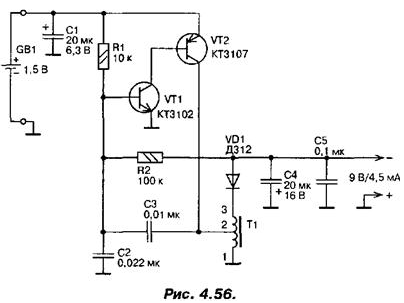
|
|
ENCYCLOPEDIA OF RADIO ELECTRONICS AND ELECTRICAL ENGINEERING Converter for remote control, 9 volts 4,5 milliamps. Encyclopedia of radio electronics and electrical engineering
Encyclopedia of radio electronics and electrical engineering / Voltage converters, rectifiers, inverters Used in some models of remote controls (RC) batteries type "Krona" have a short service life. Therefore, it is advisable to use elements of type A316 with a voltage of 1,5 V in conjunction with a voltage converter. The converter (Fig. 4.56) is a single-cycle relaxation generator with capacitive positive feedback (C2, C3). A step-up autotransformer T2 is included in the collector circuit of transistor VT1.
The converter uses the reverse connection of the rectifier diode VD1, i.e. when the transistor VT2 is open, a supply voltage is applied to the winding of the autotransformer and a voltage pulse appears at the output of the autotransformer. However, the diode VD1 switched on in the opposite direction is closed at this time and the load is disconnected from the converter. At the moment of pause, when the transistor closes, the voltage on the windings T1 is reversed, the diode VD1 opens and the rectified voltage is applied to the load. During subsequent cycles, when the transistor VT2 is turned off, the filter capacitors (C4, C5) are discharged through the load, ensuring the flow of direct current. In this case, the inductance of the step-up winding of the transformer T1 plays the role of a smoothing filter inductor. To eliminate the magnetization of the autotransformer core with a direct current of the transistor VT2, the magnetization reversal of the autotransformer core is used by connecting capacitors C2 and C3 in parallel with its winding, which are also a feedback voltage divider. When the transistor VT2 closes, the capacitors C2 and C3 are discharged during the pause through the winding 1-2, remagnetizing the core T1 with the discharge current. The open time of the transistor VT2 is determined by the inductance of the winding 1-2 of the autotransformer T1 and the capacitances C2 and C3. The generation frequency depends on the voltage at the base of the transistor VT1. Stabilization of the output voltage is carried out due to the OOS for a constant voltage through R2. In this case, with a decrease in the output voltage, the frequency of the generated pulses increases with approximately the same duration. As a result, the frequency of recharging the filter capacitors C4 and C5 increases and the voltage drop across the load is compensated. With an increase in the output voltage, the generation frequency, on the contrary, decreases. So, after charging the storage capacitor in the remote control, the generation frequency drops tenfold. Only rare pulses remain, compensating for the discharge of capacitors in rest mode. This method of stabilization made it possible to bring the quiescent current of the converter to 0,5 mA. Transistors VT1 and VT2 should have the highest possible gain to improve efficiency. The winding of the autotransformer is wound on a ferrite ring 2000NM 10x6x2 mm and has 300 turns of PEL-0,08 wire with a tap from the 50th turn (counting from the "grounded" pin). Diode VD1 must be high-frequency and have a small reverse current. The remaining parts are small-sized, of any type. After installation and adjustment, the parts of the transducer are covered with a screen made of tinplate. A correctly assembled converter starts working immediately after switching on. It is only necessary to set the output voltage to 2 V by selecting the resistor R9. To increase the service life of the A316 element, you can install a miniature power switch in the remote control. Author: Semyan A.P.
Machine for thinning flowers in gardens
02.05.2024 Advanced Infrared Microscope
02.05.2024 Air trap for insects
01.05.2024
▪ The design of the large interplanetary station Psyche is completed ▪ The danger of extinction of insects ▪ New pill replaces daily medication
▪ section of the site Stories from the life of radio amateurs. Selection of articles ▪ Biant's article. Famous aphorisms ▪ article What is an antidote? Detailed answer ▪ article Picker of materials, cut and products. Standard instruction on labor protection ▪ article Antenna amplifier. Encyclopedia of radio electronics and electrical engineering
Home page | Library | Articles | Website map | Site Reviews www.diagram.com.ua |






 Arabic
Arabic Bengali
Bengali Chinese
Chinese English
English French
French German
German Hebrew
Hebrew Hindi
Hindi Italian
Italian Japanese
Japanese Korean
Korean Malay
Malay Polish
Polish Portuguese
Portuguese Spanish
Spanish Turkish
Turkish Ukrainian
Ukrainian Vietnamese
Vietnamese

 Leave your comment on this article:
Leave your comment on this article: